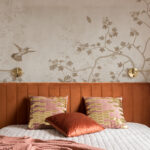How to measure various walls for wallpapering?

Measuring your wall for wallpapering is easier than you think! Honestly! Pro tip for starters: get a measuring tape! Then on – all you need is the width and height of the wall at the longest and widest possible points. Here’s our guide to measuring your wall for wallpapering. No matter what type of wall covering you are planning to install there – photo wallpaper, repeat pattern or an elegant mural wallpaper!
How to measure?
Grab your trusty measuring tape and follow these simple steps for accurate measurements:
- Measure the widest width of your wall.
- Measure the highest height from floor to ceiling.
- Don’t worry about including skirting boards or coving in your measurements.
- Our recommendation is to add 5 cm / 2 inches extra for both width and height measurements.
Various wall types
We adore walls in all their unique shapes and sizes, and we’re here to help you make them even more beautiful with wallpaper! Explore our handy wall-measuring tips through the sketches!
STANDARD WALL
Just measure the complete height and width of your wall. It’s important to be precise, so double-check your measurements before entering the digits!
MULTIPLE WALLS
If you’re planning to wrap a wallpaper around multiple walls, streamline the process by adding up the widths of each wall. The height remains the same for both walls.
PITCHED WALL
If your wall features two slanted sections, no problem! Just identify and measure the longest part of the wall in both width and height. We’ll create your mural as a square or rectangle, and any necessary cuts to accommodate the slants must be made during the installation.
WALL WITH OBSTACLES
If your wall has a door, window, or other obstacles, no worries! Just measure the entire width and height of the wall as if the obstacle isn’t there. During installation, wallpaper must be cut around the obstacle.
SLOPED WALL
When dealing with a sloped ceiling or wall, simply measure the longest and widest sections without considering the slope. We’ll deliver your wallpaper as a complete rectangle or square, and any necessary adjustments for the slope must be made during installation.






